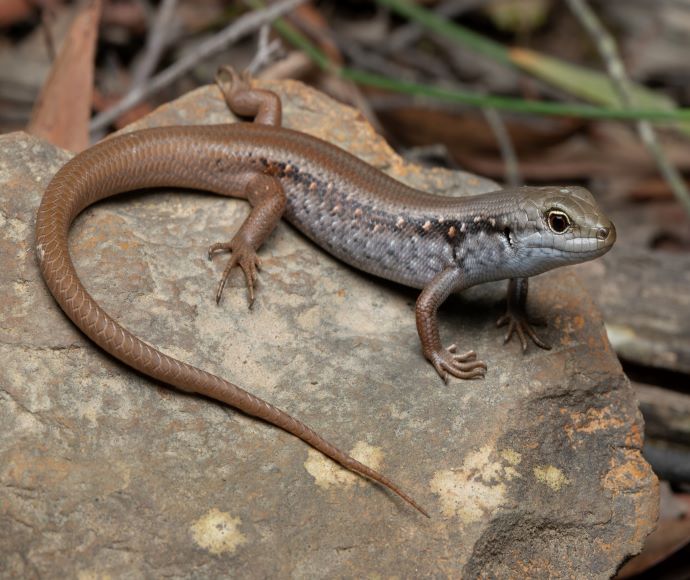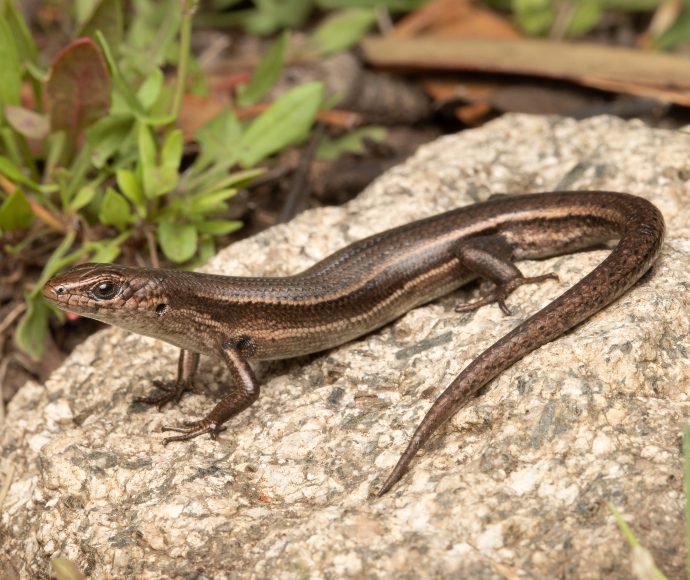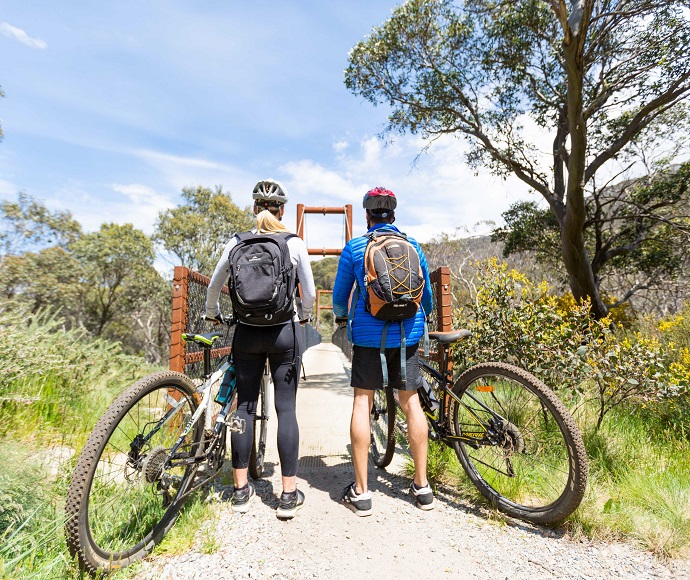Stoked on skinks: Let's protect Australia's threatened alpine skinks
Meet some of the rarely seen but important skink species, unique to our alpine regions, which face extinction without our help.
From big blue tongues and land mullets to small grey and brown garden skinks, these small-legged (or no-legged!) lizards are a common sight from Australia’s coasts to rainforests and arid areas to bustling cities.
But there are 4 special skinks that barely anyone sees, despite living in one of the most popular regions for hikers, skiers and mountain-bike riders. The Guthega skink, alpine-she oak skink, mountain skink and alpine bog skink are the ‘coldest of the cold-blooded’. They’re some of Australia’s alpine skinks, found at high altitudes in Australia’s alpine regions and nowhere else on Earth. They play a crucial role in keeping the alpine ecosystems in balance but are extremely rare and facing extinction.
Stoked on skinks
'I'm stoked on skinks! While these skinks lead private lives, if you’re walking through alpine areas and spot some granite rocky outcrops, chances are you’re travelling through the home of amazing Guthega skink!'
– Boen Ferguson, nature photographer, snowboarder and Jindabyne local.

Under threat
Just like all animals, skinks are part of the food web. They feed mostly on insects, as well as other invertebrates and plant material and have natural predators like snakes, other lizards and birds. However, these alpine skinks are under serious threat from feral animals like rats, cats and foxes, who’ve developed a taste for these endangered lizards.
Alpine skinks also face threats from feral herbivores and introduced weeds, which damage the delicate alpine ecosystem. Bushfires are a further threat to the skinks’ habitat, as we saw when large sections were destroyed in the 2019–20 bushfires, which also killed skinks, depleted food sources for those that survived and further exposed them to their predators.
Living at the highest altitudes in Australia makes these skinks unique but puts them in a tricky spot in a changing climate. As seasonal temperatures rise with climate change, their habitat gets smaller because trees and tall shrubs from lower elevations can grow further uphill into the, now warmer, alpine zone, overtaking the grassland and heathland essential for skinks. Animals that used to live at lower altitudes move upslope with the changing vegetation and can prey on or compete with skinks for habitat and food.
Did you know?
The mountain habitats of these 4 alpine skinks are so isolated that they’re sometimes described as ‘sky islands’ – each mountain top is separated from the others by a ‘sea’ of lower-altitude habitat that is unsuitable for these skinks. Such isolation means that any threat could devastate the population and make it hard for remaining skinks to survive.
Meet the alpine skinks

The endangered Guthega skink (Liopholis guthega) is a chunky, medium-sized lizard with a body length up to 11 cm. They are blackish-brown or greyish-brown in colour, with stripes along the sides of their body and striking light-coloured spots. These markings are more prominent on young skinks.
These skinks live on rocky outcrops and in open snow gum woodland with grassy or shrubby understoreys, dry tussock grassland, and tall and short heath. They occupy a small home range and share a communal burrow network, along with favourite foraging and basking areas.
It’s thought they reach maturity around 3 or 4 years old and, after mating in later spring or early summer, give birth to between 3 and 4 live young during summer. They can live for over 10 years.
In summer, Guthega skinks are often spotted basking in the sun on rocks or earth platforms they’ve made outside their burrows. In winter, they sleep through the cold alpine weather under the snow, hibernating for 5 months.
- Find out more about the Guthega skink (Liopholis guthega).
Did you know?
The Guthega skink lives at the highest altitude recorded for skinks in Australia. It lives at the top of Australia at altitudes between 1,600 m and 2,170 m.

The alpine she-oak skink (Cyclodomorphus praealtus) is a medium-sized lizard with a slender body reaching up to 13 cm in length. Each individual is uniquely coloured and patterned, with flecked scales in shades of black, grey, white, reddish-brown and olive green.
These skinks live in grassy habitat above 1,200 m. They don’t dig burrows or make nests like some of the other skinks but spend most of their time sheltering in tussock clumps and beneath litter, rocks and logs.
They mostly eat small invertebrates such as molluscs and insects.
They mature at 2 to 3 years of age, with females giving birth to between 2 and 9 young in mid to late summer. They hibernate over winter and are known to live for more than 5 years in the wild.
- Find out more about the alpine she-oak skink (Cyclodomorphus praealtus).
Did you know?
Alpine she-oak skinks have a unique behavioural trait, being a snake-like defence when under threat. Imitating a snake, they tuck their reduced limbs against their slender body, rear their head, hold out their tongue and flick the tip as a snake does. If an animal you’re watching behaves like that, move away, as it’s telling you that it feels threatened.

The mountain skink (Liopholis montana) is a stoutly built lizard that has a body length of up to 11 cm.
This species appears to be surviving in separate colonies, each having only 1 or 2 warrens with a small number of individuals. Mountain skinks construct burrow networks beneath rocks.
It’s thought that they pair with one partner and females give birth to up to 4 young.
Mountain skinks have an omnivorous diet that includes seasonal fruits.
Did you know?
Mountain skinks are mostly grey-brown and the species can be either plain-backed (without dorsal markings) or patterned (with dorsal markings). These different colour patterns occur within populations and are a result of genetic variation.

The alpine bog skink (Pseudemoia cryodroma) grows up to 6 cm in body length. Difficult to identify, it is a small, metallic brown to green-brown skink with a broad dark zone along its side.
This species mainly lives in wetlands, grassland, shrubland and forest areas above 1,100 m. These skinks live within the ground cover, emerging to bask on grass tussocks, low emergent rocks and at the base of snow gums (Eucalyptus pauciflora).
They mature at one year of age and breed in the warmer months from December to March, with females giving birth to between 2 and 5 young in February. They can live for around 5 years.
Did you know?
The alpine bog skink is known to hybridise with 2 other species in its genus, the southern grass skink (Pseudemoia entrecasteauxii) and the southern grass tussock skink (Pseudemoia pagenstecheri).
Protecting these species
Australia’s alpine skinks are key indicator species. This means they’re very sensitive to environmental changes in the ecosystem and can give an early warning that a habitat is suffering.
Both Guthega skink and alpine she-oak skink are protected as Assets of Intergenerational Significance, which means their critical habit has strong legal protection and its management is a high priority.
There are targeted conservation strategies for Guthega skink and alpine she-oak skink under the Saving our Species program. Conservation actions under these strategies include:
- monitoring
- mapping habitat
- capturing genetic data
- controlling feral pest species
- managing fire and human disturbance.
How you can help

If you’re visiting the habitat of Australia’s alpine skinks, including Kosciuszko National Park:
- ensure your boots are clean to help stop the spread of weeds and soil-borne diseases which impact both plants and animals
- keep to designated tracks
- never move rocks; they might be animal habitat
- observe and appreciate animals in their natural state from a reasonable distance; do not touch or pick them up
- take all your rubbish with you, including organic litter.